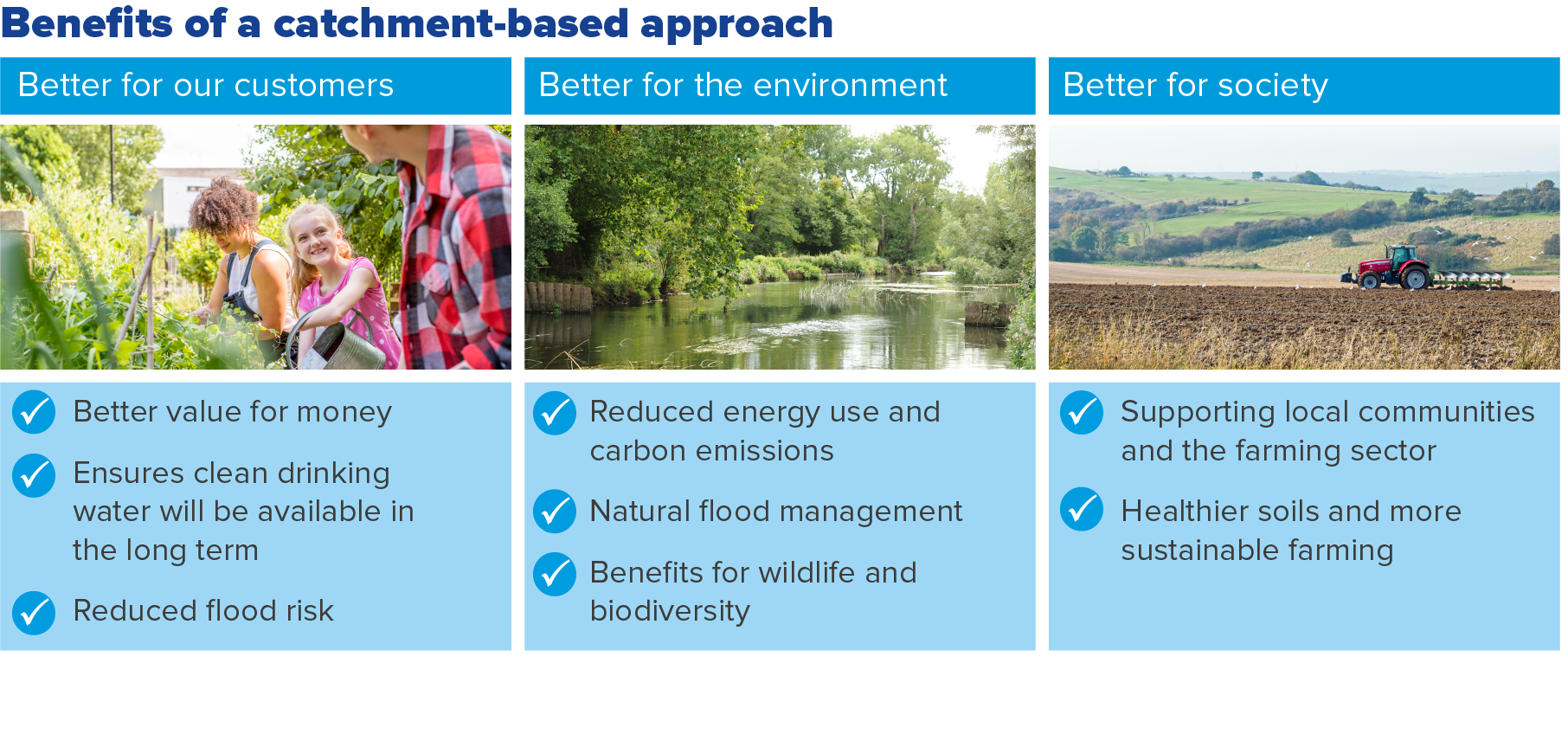About Catchment First
Catchment First is our commitment to put the well-being of the environment at the centre of the decisions we make and the services we deliver.
It means working hand in hand with nature and our partners in the catchments to protect water for our customers and the environment.
What is a catchment?
A catchment is an area where water is collected by the natural landscape – it can be a river water catchment or groundwater catchment.
The quality of our drinking water is heavily influenced by activities within these catchments. About 70% of the water we supply comes from groundwater (water stored underground in aquifers), 23% is abstracted from rivers and 7% comes from our reservoirs.
We have 98 groundwater catchments, 10 river catchments and four reservoir catchments in our region.
| Our groundwater catchments are grouped in these areas: | Our surface water catchments are defined by the following rivers: | And our reservoirs are: |
|---|---|---|
|
|
|
What is catchment management?
Our work is about taking steps to manage potential risks to help improve the quality and quantity of water in our catchments.
As water flows through a catchment, activities on the land can affect the quality and quantity of water available. The sort of activities which could pose a risk include run-off from roads, leaking sewers, farming practices and private and public abstractors.
We’re committed to supplying high-quality drinking water, and the level of treatment needed for it to reach this standard depends on the quality of the water source. The more water quality is impacted by human activity, the more we have to treat it. This increases the costs to our customers, requires more chemicals, uses more energy and increases our carbon footprint. It is better for our customers, society and the environment if we manage the causes of water quality issues rather than treat the symptoms.
We can do this in many ways, but we have found we get the best results from working in partnership with other organisations and landowners. Together, we can develop solutions to improve urban and agricultural land management, reduce risks to water quality and river flows, and create sustainable drainage to cope with heavy rain.
Traditionally, water companies have solved water quality issues by investing in treatment processes.
However, we are increasingly realising that working in the catchments to address the cause of water quality and quantity issues is a much more sustainable approach.
Taking a more natural, catchment-focused approach is better value in the long term, helping to keep water bills more affordable.
Further information
Thinking differently about the benefits of what we do
Traditionally water companies have used engineering (e.g. pipes, pumps and concrete) solutions to meet our needs to supply and treat water and wastewater services. There is now a move to consider the wider costs and benefits of what we do, going beyond just thinking about the financial cost of building and operating infrastructure. Southern Water has pledged to work in the public interest and to place wider good at the heart of what we do – we have committed to achieve net zero carbon emissions by 2030.
Natural or ‘nature based’ solutions are now being used more and more alongside traditional engineering solutions to deliver a more resilient service and wider benefits for people and nature. This ‘natural capital’ value is being included in our decision-making to ensure we are investing in the right solutions for our customers, for the environment and for wider society.
Catchment management can deliver multiple benefits compared to wholly engineered ‘end of pipe’ treatment solutions:

Who we're working with
These are just a few of the sectors we are working with:
- Farming sector – farm clusters, farmers, environmental scientists, farm advisors (agronomists), industry bodies such as the National Farmers’ Union
- Environmental organisations – the Wildlife Trusts, Rivers Trusts, Catchment Partnerships
- Government agencies – Local Authorities, the Environment Agency, Natural England, Defra
- Other water companies – South East Water, Sutton and East Surrey Water, Affinity Water, Thames Water, Portsmouth Water
- Other sectors – Highways Agency, Network Rail, industry (e.g. pharmaceutical companies), garden centres, amenities (e.g. golf courses, allotments)
Our Catchment First principles
- Regulatory – meeting the standards set by water industry regulators
- Resilience – improving our water environment so it’s able to support our growing population and changing climate
- Compliance – making sure drinking water sources, rivers and seas meet high quality standards
- Partnership – working with others to achieve the best overall benefits
Catchments and the water cycle
Catchment management is about the whole water cycle.
Water is continually moving between different forms – from rivers, lakes and seas, water evaporates and forms clouds, where it cools and falls back to the earth’s surface as rain or snow. This supplies the rivers and underground aquifers from which we take water to supply our customers No new water is created so it’s important we look after this vital resource.
The combination of climate change and our region’s growing population will put increasing pressure on water supplies. We therefore need to make sure our abstractions are sustainable and the water environment is resilient to changing conditions such as drought and flooding.
Fact
730mm
The amount of rain the South East averages in a year